Summary of Findings
It has been almost a year since FTX went bankrupt on November 11, 2022. Some of the ways that has impacted EA have been obvious, like the shuttering of the FTX Foundation, expected to be one of the biggest EA funders. But recent discussions show that the broader impact of the FTX scandal on EA isn’t well understood, and that there is a desire for more empirical evidence on this topic. To that end, I have aggregated a variety of publicly available EA metrics to improve the evidence base. Unfortunately, these wide-ranging perspectives clearly show a broad-based and worrisome deterioration of EA activity in the aftermath of FTX.
Previous attempts to quantify how FTX impacted EA have focused on surveys of members of the EA community, university students, the general public, and university group organizers. These surveys were conducted in the months following FTX’s collapse. Their results have been framed as relatively innocuous by the researchers who conducted the surveys and CEA leadership, as exemplified by how Ben West (interim Managing Director of CEA) introduced a June forum post on this topic:
From the research we have on attitudes toward EA from the EA community, the general public, and university students, it seems that the FTX crash hasn’t, overall, impacted sentiments toward EA very much. This is not to say that FTX has not significantly impacted people in many ways, including mental and emotional health, levels of trust in EA leadership, and increased uncertainty in EA as a movement. (emphasis added)
Other community members interpreted the survey responses of the EA community in a much more negative light, particularly noting the large magnitudes of decreased satisfaction (“0.5-1 points on a 10-point scale … [to] ~7.5/10”) and the percentage of respondents (30%) saying “they had substantially lost trust in EA public figures or leadership”. This more negative interpretation seems well supported by my analysis of a much more comprehensive, and more up-to-date, set of metrics that measure the behaviors these attitudes motivate.
A clear inflection point is apparent across metrics after FTX collapsed, and subsequently we can observe a persistent, ongoing, and meaningful negative impact on most publicly available EA metrics. These negative impacts are apparent throughout the EA “growth funnel”:
- Top of the funnel: subscriptions to the EA Newsletter were increasing by ~290/month prior to FTX and are now contracting by ~150/month. Traffic to the Intro to EA page on effectivealtruism.org is now at the lowest levels since 2017.
- Middle of the funnel: assorted EA Forum usage metrics are now plateauing or declining after a long period of rapid growth pre-FTX. Donors/donations to EA Funds have also been negatively affected; after years of consistent growth, the number of EA Funds donors has been steadily falling post-FTX.
- Bottom of the funnel: the rate of new GWWC pledges is down ~70% post-FTX, and participation in the In-Depth Virtual Program has slowed meaningfully.
My goal in conducting this analysis is to facilitate a better answer to the question: what has happened to EA in the wake of FTX? I see this as the first of three important questions. These questions need to be addressed sequentially and for that reason, I have intentionally avoided the two subsequent questions. But I hope a better understanding of what has happened will allow the community to address these other questions going forward:
- Why did FTX impact EA the way it has? (For instance, how can we disentangle the effects of reduced funding being available, disillusionment with EA principles, disillusionment with EA leaders, and other factors? I have included a list of additional data that would facilitate that sort of attribution.)
- Given what has happened, and why it happened, what should be done next?
These questions are important to answer, but that cannot be done without an accurate understanding of what has happened to date. I hope the evidence I’ve collected will help with that endeavor.
Detailed Findings
Notes on Data Sources and Presentation
Unless otherwise noted, the data presented below comes from CEA’s dashboard and the EA Funds dashboard. Data from CEA’s dashboard was accessed when it had last been updated in mid-September. Immediately prior to publication, I noticed that this dashboard had been updated again on October 9. I don’t believe that additional data changes the overall picture enough to warrant a rewrite to include it, though I do note that the metrics for subscriptions to the EA Newsletter and visits to the Effectivealtruism.org Intro page showed some encouraging upticks in September. EA Funds data extends through the end of September.[1]
When charts are presented below, I’ve included a red line to indicate the timing of FTX’s collapse. For monthly data series, I’ve marked November; it’s worth bearing in mind that FTX went bankrupt mid-month on November 11th.
Donation Data
EA Funds: Donation and Donor Data
FTX has had an obvious negative impact on the number of donors giving through EA Funds. Since EA Funds was founded in 2017 it had experienced positive year over year growth in the number of monthly donors every single month (albeit at a slowing rate); this lasted until December 2022, the first full month after FTX’s collapse. 2023 has seen declines relative to 2022 of ~10% at the start of the year deteriorating to ~20% in September. September 2023 had the fewest donors of any month since November 2020.
The 2022 giving season, which immediately followed FTX’s collapse, also illustrates the speed and degree with which the scandal impacted EA Funds donors. Averaging across the five previous years, December had 36% more donors than November. 2022 saw an increase of only 6%; in other words, the FTX scandal essentially eliminated the effect of giving season for this metric.
FTX also appears to have had a material negative impact on the amount of money donated through EA Funds (though this metric is more susceptible to large outlier donations). The EA Funds dashboard shows donation data dating back to 2020. Through the end of September (the last month of full data at time of writing), donations in 2023 were -23% behind 2022, -57% behind 2021 (a particularly strong year), and just 6% ahead of 2020 at the same time of the year.
These figures would look even worse if not for abnormally large September 2023 donations to the EAIF ($432k donated in September vs. a total of $480k raised from January-August) and the LTFF ($875k donated in September vs. a total of $1.3 million from January-August). As of the end of August, 2023 donations were -35% behind 2022, -66% behind 2021, and -12% behind 2020.
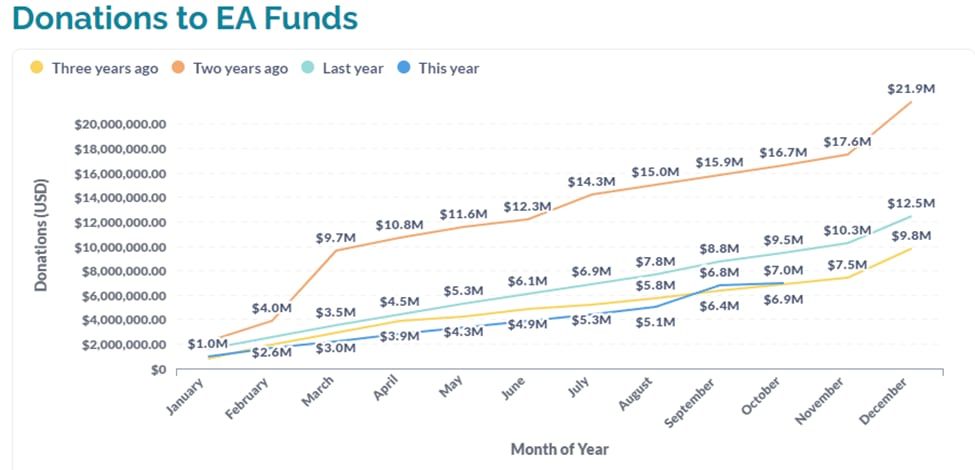
Note: October 2023 data in this chart should be ignored, as it only captures a small part of the month’s giving.
Like the number of donors, the amount donated through EA Funds also suffered in the giving season that immediately followed FTX’s collapse. December 2022 donations were 2.6x the average of the previous three months, compared with 5.2x in 2021 and 4.3x in 2020.
GWWC Pledges
Pledge data from Giving What We Can shows a clear and dramatic negative impact from FTX. The rate of new monthly pledges has declined ~-70% from 2023 vs. 2022 (even if one ignores January 2023’s -80% decline vs. January 2022 which might be due to the lack of a 2023 pledge drive.) This slowdown appears to be persistent and ongoing. [2]
EA Newsletter Subscriptions
Prior to FTX, the subscriber base of the EA Newsletter had a long track record of steady growth. Since its collapse, the newsletter has been losing existing subscribers faster than it has been acquiring new ones.
From the start of June 2020 through the start of November 2022, the newsletter steadily gained an average of 289 subscribers per month. Over that period, it only lost subscribers in a single month (just 4 subscribers in November 2020). From the start of December 2022 through the start of September 2023, the newsletter lost an average of 153 subscribers per month. At time of writing, this new trend shows no sign of abating. This data suggests that the FTX collapse has negatively impacted the EA Newsletter by ~440 subscribers per month.
Attitude Data
Survey of EA Community
Several surveys have been conducted to help assess how FTX has impacted EA. Prior to this analysis, these surveys were the most rigorous attempt to measure that impact.
In December 2022, Rethink Priorities (together with CEA) surveyed the EA community. Key findings were:
- “FTX had decreased satisfaction by 0.5-1 points on a 10-point scale within the EA community… [to] ~7.5/10”
- “30% said they had substantially lost trust in EA public figures or leadership”
- “Around half of the respondents reported that the FTX crisis gave them concerns with EA meta-organizations, the EA community and its norms, and the leaders of EA meta-organizations.”
Another important finding, which I consider woefully under-discussed, is that “a sizable minority (38%) reported that they were less likely to associate with EA due to this crisis.” Half of those respondents agreed or strongly agreed with that statement. I consider this figure alarmingly high, but this finding was not included in the summary of survey results nor a follow-up post about the survey.
There is not a consensus on how to interpret the survey results. An author of the survey believes the evidence “suggests a relatively limited reduction in morale post-FTX.” However, numerous commenters interpreted the data as more dramatic (a view I’m highly sympathetic to).
For example, one commenter observed that “[decreased satisfaction by 0.5-1 points on a 10-point scale is] a big drop! In practice I've only ever seen this type of satisfaction scale give results between about 7/10 through 9.5/10… so that decline is a real big chunk of the scale's de facto range.” Another commenter noted that “The headline finding here for me is the HUGE negative response within the EA community, especially the reduction in trust of leaders which will in turn have a roll on effect on our ability to reach out and grow the movement.” [emphasis original].
It’s also worth noting that this survey was conducted before additional negative information came to light (including allegations that EA leaders had been warned about SBF’s behavior, revelations about Owen Cotton-Barrat’s sexual misconduct and how it was handled by the community health team, Nick Bostrom’s apology for an old offensive email that some found extremely underwhelming, and heightened discussion of the Wytham Abbey “castle” purchase). As one EA observed (in March), “I'd expect this to look significantly worse if done in March rather than Dec :(“
Surveys of University Populations and General Public
While the December survey looked to capture how existing EAs felt about the FTX collapse, other surveys looked at whether non-EA populations had acquired a negative view of EA due to FTX. These surveys did not find strong evidence of that dynamic, largely because awareness of EA is quite low (a dynamic which could change going forward via increased attention to FTX):
- A May 2023 CEA survey of university group organizers found minimal concerns about how the groups are “perceived on campus” and very little concern about FTX specifically.
- When Rethink surveyed university students (not affiliated with EA) from November 2022 to February 2023, most respondents hadn’t encountered EA before and “only 13/233 (5.6%) respondents who had encountered EA found FTX or SBF salient enough to mention when interviewed.”
- Rethink also ran pre-and-post-FTX (the latter in February-March 2023) surveys in the US general public and found “Awareness of EA remains low, and ~99% of people who were aware of EA did not mention FTX” and “Among those aware of EA, attitudes remain positive and actually maybe increased post-FTX —though they were lower (d = -1.5, with large uncertainty) among those who were additionally aware of FTX.”
Engagement Metrics
EffectiveAltruism.org Web Traffic
It seems clear that FTX has impacted traffic to EffectiveAltruism.org, though the nature of that impact is somewhat ambiguous. My interpretation is that the FTX scandal dramatically increased traffic to the EffectiveAltruism.org homepage, but probably (though not definitively) led to a decrease in traffic from people who wanted to learn more about EA.
Traffic to the homepage had been roughly range-bound between 10-20k views/month from April 2017 to July 2022. At that point, traffic leapt dramatically up to ~50k views in October, presumably due to the media blitz around the release of What We Owe the Future. November, the month of FTX’s bankruptcy, saw views almost double from the already elevated October levels. Since then, traffic has fallen quickly but remains well above the long-term range.
It is difficult (at least with publicly available data) to disentangle how much post-FTX traffic is due to FTX as opposed to WWOTF or other sources. It’s also not obvious if we should interpret post-FTX traffic as a good thing or a bad thing. If people are visiting the site and becoming interested in EA that’s probably good; if people are visiting the site because they want to learn more about how SBF was virtue signaling while committing fraud, that’s presumably bad. As discussed in the Google search interest section, after FTX more of the searches related to EA have negative connotations (e.g. people searching for “effective altruism cult”) which suggests we should be wary of the quality of homepage traffic.
CEA also provides data on traffic to the “intro to EA” page. I think changes in this metric are a reasonable proxy for “changes in traffic we want” (since it captures people trying to learn more about EA). This traffic has been declining steadily since FTX, and the last few months have registered the lowest levels since the data history starts in 2017. This of course suggests that FTX has had a serious negative impact. However, one could also interpret the data as indicating that the post-FTX decline in intro page traffic is actually a continuation of a decline that started in February 2022 and was temporarily interrupted by the release of WWOTF. Clouding this picture further, while we know intro page traffic was lower in June 2022 than in February 2022, unfortunately “data from March-May 2022 is unreliable due to a technical configuration error.”
While I acknowledge the ambiguity around the interpretation of the intro page traffic data, my personal interpretation is that FTX likely had a moderate to severe negative impact. I find it hard to believe that a) the longest (by far) sustained decline in traffic since 2017 and b) a decline to the lowest levels of traffic since 2017, the timing of which both correspond perfectly to FTX’s collapse, are not significantly driven by said collapse.
EA Forum
A variety of EA Forum metrics are available through CEA’s dashboard. FTX appears to have stopped, and possibly reversed, the long, consistent trends of growth these metrics had previously been experiencing.
Generally speaking, these metrics have been climbing rapidly since the data starts (in 2019 or 2020 depending on the metric) and peaked when FTX collapsed. Metrics that include community posts saw an especially high peak (indicating very high forum engagement around the collapse itself) and also show a noticeable early September spike (presumably associated with the controversy around Nonlinear). Since FTX, all these metrics have been on a clear declining trend, and are generally back to similar levels as ~12-16 months ago.
- Hours of engagement (community, non-community, combined) and Views by Forum users: have been largely steady the last few months (aside from Nonlinear related spike), roughly back at similar levels to April 2022, a clear departure from pre-FTX growth trend.
- Monthly active logged in users: this metric had been experiencing particularly fast growth prior to FTX (e.g. October 2022 was up 143% vs. October 2021). After FTX, the trend changed from rapid growth to modest decline. The August 2023 reading is essentially unchanged vs. August 2022.
- Number of Forum posts with 2+ upvotes: This metric (which I consider the least important of these forum metrics by a pretty wide margin) actually peaked in August 2022 (following a large spike in July), prior to the FTX collapse; I suspect this was largely due to the Red Teaming contest. Since then, the metric has declined to approximately April 2022 levels. This could indicate that FTX halted a pre-existing growth trend. However, the summer 2022 spikes conflate the picture, and one could also argue that current values are basically in line with the trend of growth from 2020 and 2021.
Google Search Interest
Since the start of 2022, Google search interest for “Effective Altruism” fluctuated modestly until July, noticeably increased around the release of What We Owe the Future, then quickly returned to roughly the high end of the original range. Search interest then spiked when FTX went bankrupt before quickly fading. Since March 2023, interest has been essentially indistinguishable from the first half of 2022.
This chart shows worldwide Google Trends data for the term “Effective Altruism”.
That said, the proportion of people searching for EA for negative reasons has almost certainly increased post-FTX. This suggests that the number of people searching for EA because they see it as something positive they might want to engage with has very likely declined post-FTX.
The magnitude of this effect is tough to measure, but we can get some indication that it is non-trivial from what Google shows as the “top related queries” for EA. The first 3 months of 2022 (pre-FTX collapse) have 19 of these related queries, only the last of which (“effective altruism criticism”) is clearly negative. Meanwhile, 8 of the 19 top related queries for June 1- September 1 2023 seem to have clear negative implications (e.g. “effective altruism cult”) with half of those directly related to FTX (e.g. “sbf effective altruism” and “caroline ellison”).
EA Global and EA Global X
CEA’s dashboard provides some data about EAG/EAGX. I find it hard to draw meaningful conclusions about FTX’s impact from this data, but I include it for the sake of completeness.
There are two EAG conferences that could offer comparisons between 2022 (pre-FTX) and 2023 (post-FTX) iterations: EAG London and EAG San Francisco (2022)/EAG Bay Area (2023). The London conference had increased attendance and “connections” and a roughly unchanged likelihood to recommend in 2023 relative to 2022; the SF/Bay Area conference saw declines across the board.
I don’t draw much from this data. First of all, since EAGs are highly selective, applicants would be a much more meaningful metric than either Connections or Attendees. (I’ve asked the Events team for data on applications, but received no response). In a possibly encouraging sign, in April 2023 Ben Todd noted that “I've also heard that EAG(x) applications didn't seem affected.” The quantitative data we do have on Connections and Attendees is probably distorted by factors like venue capacity (as venues shifted from 2022 to 2023 in both cases). Also, it might not be appropriate to compare EAG SF 2022 to EAG BA 2023, due to the different (albeit nearby) location, different timing (July 2022 vs. February 2023), and less availability of travel funding.
I think it is even harder to draw firm conclusions about FTX from EAGX data. Berlin is the only location that ran EAGX conferences both pre-and-post FTX. While Connections and Attendance both fell considerably post-FTX, the 2023 conference had a reduced budget and had to limit the conference size. It’s conceivable FTX contributed to the reduced budget, but without confirmation from the organizers that is pure speculation.
Virtual Programs
CEA runs several types of virtual programs, the largest of which are an Intro program and an In-Depth program. FTX appears to have had a negative impact on participation in these programs. Monthly cohorts in 2022 were larger than their 2021 counterparts, but 2023 participation has generally shrunk (often quite significantly) relative to 2022.
[Methodological note: No programs have data for December 2022. I’m not sure why that’s the case, or if FTX’s recent collapse influenced it in any way. In this chart, I compared January 2023 data with the sum of December 2021 and January 2022 data on the assumption that people who would have been in the December 2022 cohort joined the January 2023 cohort instead.]
80k Metrics
In early April 2023, Ben Todd commented that “80k's metrics seems unaffected so far, and it's one of the biggest drivers of community growth.” This does seem encouraging, though of course it would be very helpful to have specific (and more up-to-date) data from 80k. While 80k published a thorough review including numerous metrics in March 2023, these metrics only extend through the end of 2022 and are provided on an annual basis, making it impossible to discern how FTX has impacted them.
[Edit: 80k has now shared updated metric numbers. These generally look better than the other metrics I've looked at, and don't appear to show a big impact from FTX.]
University Group Accelerator Program
While CEA provides participation data on UGAP, I don’t believe it is possible to do a pre-and-post-FTX comparison on an apples to apples basis, since CEA decided to narrow UGAP to only new university groups (as discussed in this retrospective).
Additional data that would shed more light on FTX’s impact and its causes
The information above comes from publicly available sources. Other data would allow for a deeper understanding of FTX’s impact and the mechanisms through which it occurred. For instance, an increase in people unsubscribing to the EA Newsletter seems likely to be driven by disillusionment with EA and/or EA leadership, while a decrease in new subscriptions is more plausibly driven by reduced funding for outreach.
Below, I’ve listed additional data I believe would be particularly useful; I hope those with access to this data will share it with the broader community.
- To what extent has the net decrease in EA Funds donors been a function of slower acquisition of new donors vs. lower retention of existing donors vs. a combination of the two? Are the donors who aren't renewing their gifts longtime donors or recent acquisitions?
- To what extent has the net decrease in EA Newsletter subscribers been a function of slower acquisition of new users vs. faster rate of unsubscribers vs. a combination of the two? Have unsubscribers provided reasons for unsubscribing? Are longtime subscribers or more recent subscribers unsubscribing at a faster rate?
- Has GWWC seen a decline in pledge adherence in addition to the slowdown in new pledge acquisition discussed above? Have trends for donations through GWWC changed since FTX?
- Have donations through GiveWell or Animal Charity Evaluators been affected?
- What are 80k’s key metrics, and how (if at all) have they changed post-FTX?
- How did FTX’s collapse affect applications to EAG/EAGX?
- Now that the new school year has begun, are university group organizers still unconcerned about how they are perceived on campus and FTX’s contribution to that perception?
- Has EA group creation/membership been affected by FTX? Is it possible to disentangle the effects of reduced funding from reputational effects?
- How has FTX impacted EA’s reputation in EA adjacent communities (e.g. the Bay Area technology community)?
- In the next EA Survey, how do respondents describe changes in their behavior that have resulted from FTX and their motivations for making said changes? What changes in the community do they most want to see and why?
- Do we have more granular data on the visitors to the effectivealtruism.org homepage that could indicate why they are visiting and how they are engaging?
- Has the average number of sessions attended by Virtual Program participants (and/or other engagement metrics for this program) been affected by FTX?
- What can search analysis/SEO tools that are more sophisticated than Google Trends (the basis of the Google search section above) tell us about changes in search behavior related to EA?
Conclusions
Across a wide variety of metrics, FTX’s collapse appears to have had a significant negative impact on EA. The metrics that may have been less affected or even unaffected, like 80k’s metrics and EA Global applications, are also the metrics that have the most out of date, most anecdotal, and least quantitative data. Where quantitative time series data is publicly available, there is a clear and consistent negative inflection point when FTX went bankrupt.
The metrics included in this analysis generally relate to people in, or at least on the cusp of, the EA community. Surveys of people outside of EA largely find that those people simply aren’t aware of EA. This lack of awareness has likely mitigated FTX’s negative impact on EA, at least in the short-term.
But I suspect we’re only at the end of the beginning of this saga. As the FTX/EA connection becomes more salient due to SBF’s trial and upcoming book/film projects, many more people will become aware of EA and this awareness will come with negative connotations. We’ve seen meaningful changes in behavior post-FTX from people who previously viewed EA in a very positive light. It seems reasonable to believe that people who have no prior attachment to EA and learn about it in the context of a high-profile fraud could have an even more intense reaction.
How has FTX’s collapse impacted EA? According to the data, the impact has been quite bad, and one that we might reasonably expect to get worse going forward. This is an unfortunate state of affairs, but it does us no good to ignore it. Without an understanding of what is happening, it is impossible to formulate a good plan about what to do about it.
Appendix: Meta commentary about data collection and distribution
The process of writing this post has only strengthened my conviction about an issue I’ve previously noted: I believe the community should assign responsibility to, and funding for, one or more people or organizations to conduct and disseminate this sort of high-level analysis of community growth metrics. I honestly find it baffling that measuring the growth of EA and reporting findings back to the community isn’t someone’s explicit job.
This certainly isn’t a novel observation. In 2017, Josh Jacobson noted that even at that time such measurement felt long overdue:
I would have expected one of CEA's very first activities, years ago when EA Outreach was established, to begin trying to measure subscription to the EA community. Gathering statistics on number of people donating, sizes of donations, number that self-identify as EAs, percentage that become EAs after exposure to different organizations/media, number of chapters, size of chapters, number that leave EA, etc.
Some progress has been made. I want to acknowledge that two of the most useful data sets for conducting this analysis, dashboards for CEA and EA Funds, are relatively new creations. Their creators deserve credit for making this data publicly available.
However, I find it deeply troubling that CEA leadership does not seem to have incorporated data from those sources into public comments about how FTX’s collapse has impacted EA. This also makes me worry that candidates for CEA’s permanent CEO position, and the hiring committee, might not have an accurate understanding of the current situation. It seems plausible that shifting the current trajectory and restoring community confidence in EA leadership should be at or near the top of the priority list for whoever ends up in that role.
Evidence-based decision making is a defining characteristic of EA (the first words on CEA’s homepage are “Combining empathy with evidence”), but the mere availability of data is not sufficient. Evidence-based decision making requires distributing that data to stakeholders and having those stakeholders use that information to guide their thinking and actions.
It seems obvious to me that numerous stakeholders-- including organization leaders, donors of all sizes, group leaders, and entrepreneurs-- would all benefit from having an accurate understanding of EA’s growth trajectory. And it seems just as obvious that it would be tremendously inefficient for each of those parties to conduct their own analysis. It would be in everyone’s interest to receive a regular (every 3-6 months?) update from a reliable analyst. This wouldn’t be expensive (it wouldn’t require anything close to a full-time job initially, though the frequency and/or depth of the analyses could be scaled up if people saw value in doing so). As public goods go, this should be an easy one to provide.
Thanks to a handful of reviewers for their helpful comments and suggestions.
- ^
While the upticks are definitely encouraging, and could represent “green shoots”, it’s possible they are related to seasonal strength in September associated with the start of the school year. In general, I think year over year percent changes are the best way to look at these sorts of metrics because this approach adjusts for seasonality. I used this year over year approach throughout this analysis when I could easily access raw data in spreadsheet form (e.g. via the EA Funds dashboard which allows data downloads) but not when it would have required significant data entry (e.g. data from the CEA dashboard, which does not have a download functionality).
- ^
Pledge data from January 2022 through March 2023 is sourced from this table. The Wayback Machine provides data for GWWC’s pledges at the end of March 2023, and Giving What We Can’s website (accessed 10/3/23) provided an updated figure. I evenly allocated the 131 new pledges acquired during that period across April-September 2023.

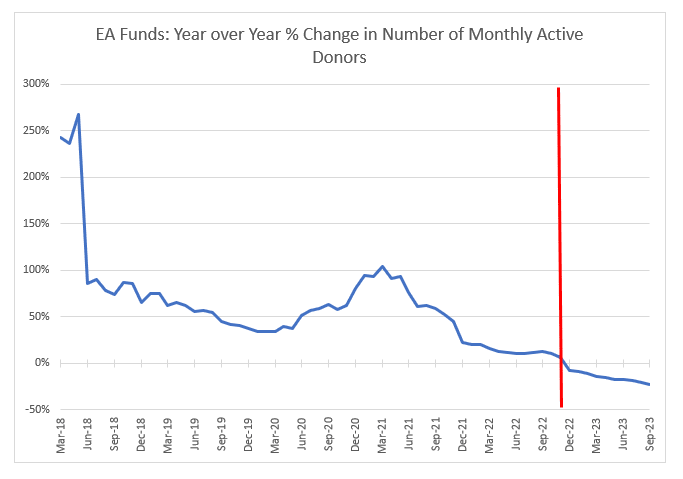
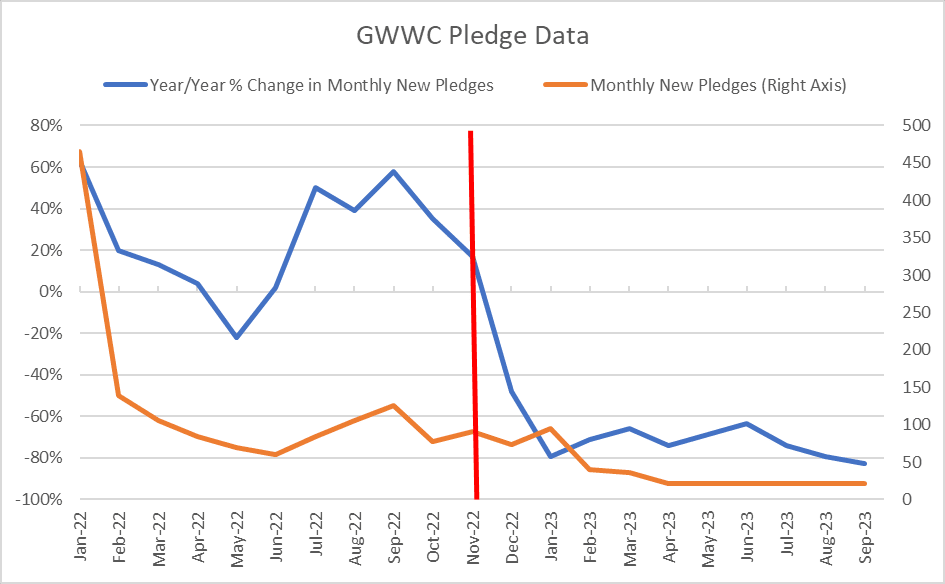
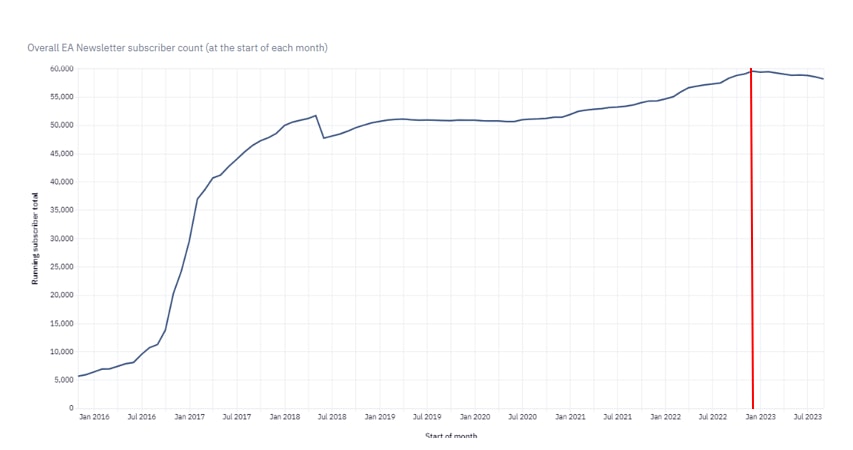
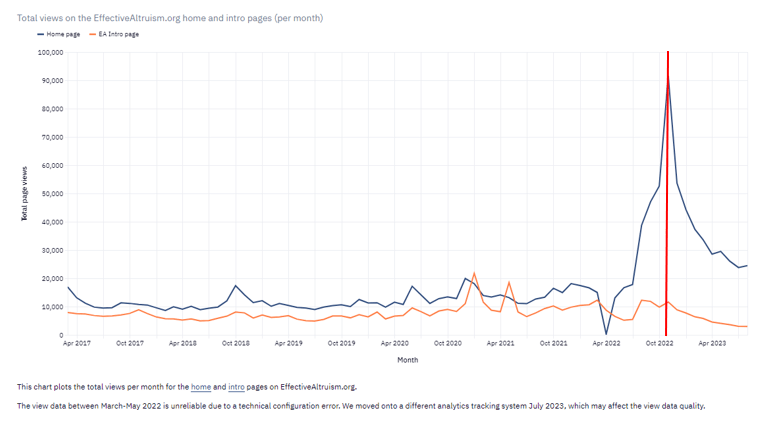
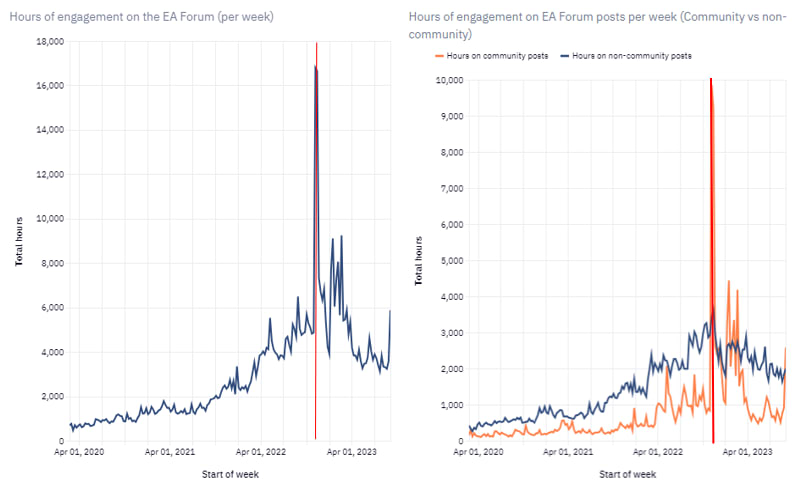
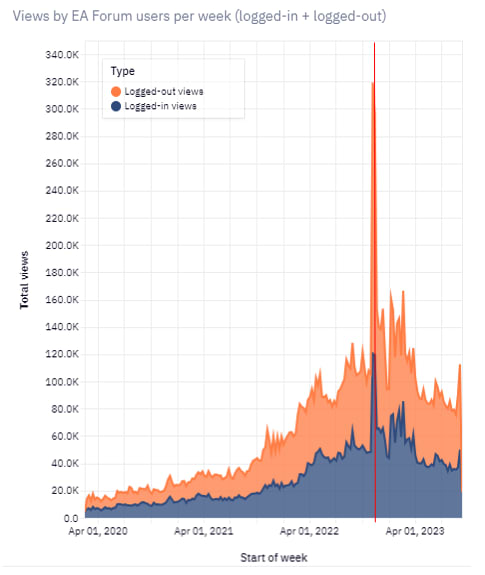
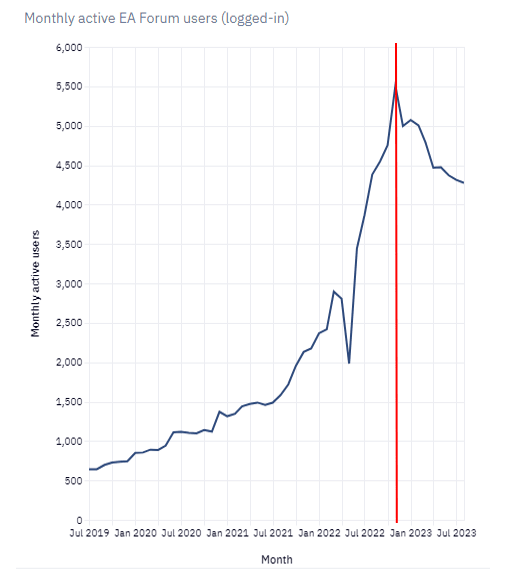
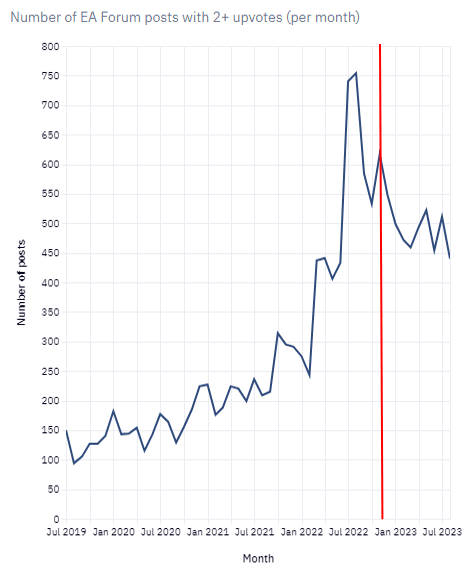
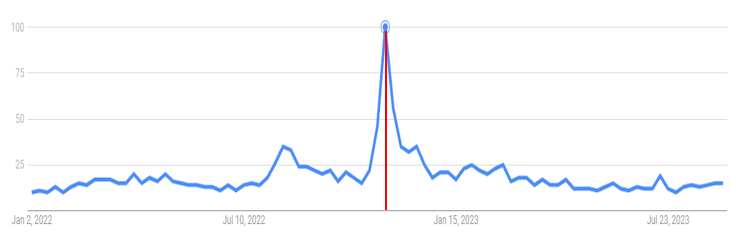
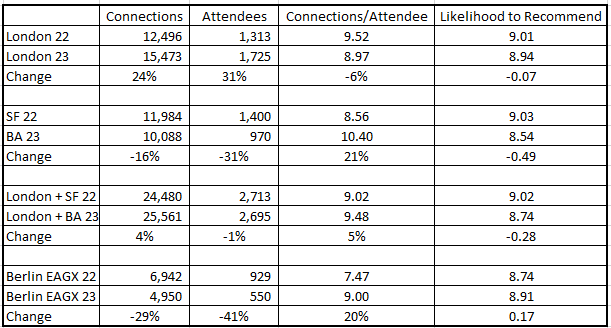
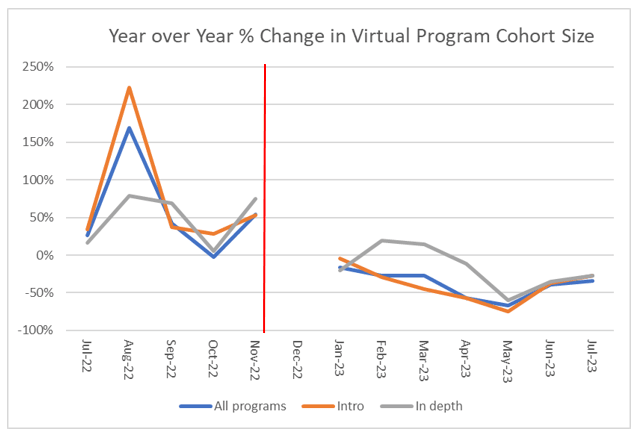
Hey! I work at 80k doing outreach.
Thanks for your work here!
I think the data from 80k overall tells a bit of a different story.
Here’s a copy of our programmes’ lead metrics, and our main funnel metrics (more detailed).
As you can see, some metrics take a dip in Q1 and Q2 2023: site visitors & engagement time, new newsletter subscribers, podcast listening time, and applications to advising.
I’d like to say four things about that data:
To make a more general point, I think a number of the metrics you cite in the post show returning to levels from early 2022, or 2021, which (at least to me) doesn’t seem like ‘worrisome deterioration of EA activity’ but rather something more like ‘a return to a historically normal level of growth for EA.’
Thanks so much for sharing this data Bella! I agree 80k’s metrics look a lot better than everything else I looked at. I’ll add an edit to the OP to that effect, and will link to your comment. To the extent 80k is doing something different from other orgs that could explain the better performance, it would be great to identify that (I wonder if your third point about advertising might be a differentiating factor).
I disagree with this interpretation pretty strongly. The metrics that have returned to early 2022 levels are basically the EA Forum metrics, which had been experiencing extremely rapid growth since 2019/2020. Even if those fast growth rates were unsustainable, the baseline expectation should probably be that the high growth rates gradually slow down and flatten out, not that they abruptly shift to zero growth (which is basically what we see with the forum metrics). EA Funds metrics, where we also have long data history, are back to 2020 levels. Effectivealtruism.org Intro Page views are at the lowest levels ever, after many years of being rangebound. And the EA Newsletter had years of relatively steady subscriber growth that abruptly flipped to subscriber losses after FTX.
So I’d argue that for the publicly available data series with the longest histories, we’re not seeing a “normal level of growth”. While growth had generally been the norm pre-FTX, we’re now either seeing zero growth (EA forum metrics) or outright contraction (EA Funds donations/donors, EA.org intro page, EA newsletter).
Also, if you had asked for growth predictions in September 2022 -- and told the forecasters that 2023 would be a year in which public awareness of / interest in the nearness and risks of powerful AI greatly increased -- one would likely factor this information into the prediction in addition to historical trends.
By rough analogy, if the stock market is unexpectedly up 25 percent over last year, your sector is up 35 percent, but your company's stock is flat . . . the market seems to be saying something negative about your company. The flat stock value may well mean that positive macroeconomic trends and sector trends have been cancelled out by negative outlook on your company.
Thanks for replying & editing the OP — appreciate it! :D
Yeah — to my knowledge, we have the biggest team focused on outreach of any (single) EA organisation (3 FTE). I think this is probably a big part of it.
I think that's fair enough — we're talking about "telling a story" about a bunch of data points here, across several years, each of which might have a whole load of complex factors driving them. I think my view here is not very resilient to new info/new ways of looking at it, and I agree some of the data seems like it fits a lot better with your high-level story with mine.
That said, I'd point out that:
Off-topic but asking for personal interest:
Would you be up for explaining (briefly) how you calculate your podcast metrics? E.g.
(I couldn't figure out what Big 3 was in this context nor your March 2022 method)
Basically we're grabbing analytics from Apple Podcasts, Spotify for Podcasters and Google Podcast Manager (which internally I call the 'Big 3'), and adding them up.
But Spotify and Google Podcasts only became available around/after Nov 2019. Drop me an email if you'd like to discuss! :)
I lead the team at GWWC and thought it might help for me to share some quick context, clarifications, and thoughts (sorry for the delay, I was on leave). I've kept this short and in bullet points.
My general observation is that both regular and high-profile pledgers/donors who would normally have been the most engaged and best advocates for us have been less likely to do so post-FTX-collapse (not just because of the FTX-collapse). This also seems to be because they're the ones that are most likely to be aware of the collapse and other issues. Since advocacy is so important to our outreach efforts, this reduction in the willingness and motivation of existing pledgers and donors to advocate (along with potentially losing new pledgers who were close to signing but who then distanced themselves because of the FTX association) seems more of a problem to me than the general public being aware of an FTX connection or any other issues.
This line surprised me, as my impression was that GWWC is essentially autonomous. Who gave this instruction? The EV board? I think the decision was reasonable, I’m just trying to understand how it was made.
It was a board level decision.
While that is largely true for day to day operations, EV UK and EV US are still essentially responsible for the actions of their projects.
This is very surprising to me (though I don't doubt you it happened). My impression from reading other things put out by EV has been that the individual orgs were meant to be very independent. For example here Rebecca explicitly lists you as being responsible for "strategic" issues with GWWC; if this does not count as a strategic decision I struggle to see what would.
The GWWC team are responsible for our strategy. This was a legal response decision (while it obviously affected our strategy and day-to-day operations).
The page you linked to lists pledges as the very first item under strategy. Pledges seem like a pretty core activity to GWWC, and the decision not to hold a pledge campaign a clear example of a strategic decision.
Legal decisions are not a separate magisteria from strategic decisions. Lawyers provide input into strategic decision making, by informing decision makers about the tradeoffs and legal risks of different options. At times they might give very strong advice. But lawyers do not give advice about non-legal consequences of actions, and nor will they give precise probabilities; they are not equipped to weigh legal considerations against other factors, and so ultimately the decisions fall to management, not the lawyers. The decision to not hold a pledge drive involves a tradeoff of (apparently) some legal risk to EV against the good that those pledges could have done for the poorest people in the world; EV's lawyers are not qualified to make that decision. This was a strategic management decision that EV's board took for you.
Perhaps part of my confusion here is coming from being unable to understand what legal reasons would lead to the banning of pledge drive or donation campaign. I don't see what supposed legal risk EV would be incurring by encouraging people to donate to AMF, or to promise to do so in the future. Maybe you're afraid that EV might be bankrupt, so you don't want to solicit donations to the non-bankruptcy-remote EA Funds, but that shouldn't entail an end to all GWWC campaigns.
Per my original comment, I agree that the EV decision (driven by legal considerations) obviously impacted GWWC strategy and day-to-day operations.
“Management” ultimately flows up to the board (and then EV recruited an Exec team to handle entity-wide decisions and processes for EV UK and EV US).
In a fiscal sponsorship scenario the fiscal sponsees actions can affect one another so it isn’t simply the case that an individual project can/should only think of their own risk appetite. During a crisis period I can understand the fiscal sponsor management not having the capacity to review all communications/decisions and therefore temporarily having blanket rules that sometimes may turn out to not have been necessary or nuanced enough after the fact.
In the comment you linked to Rebecca said that the Interim CEOs are responsible for “charity-wide issues, including legal response, coordination, and org structures, etc (that is, things that span multiple projects: 80k, CEA, GWWC, etc)” and prior to them being hired that fell to the board. This decision was part of the legal response/coordination and not a decision for project leads to make.
Note that I said we paused the giving season campaigns around the time of the crisis, we didn’t decide not to have a pledge campaign entirely (though the pause and the crisis itself did negatively impact pledges significantly).
To clarify: are you just saying that the campaigns were paused but then eventually resumed (which was my understanding), or that the giving season campaigns (which were paused) are distinct from some other kind of pledge campaign, which were not paused?
Thanks for clarifying. FWIW, given community desires for more communication from leadership and greater transparency, I think it would have been good for the board to share this decision publicly.
While I agree in terms of the ethos, I also understand the difficulty and a reasonable amount of the complexity of the situation and why this would have been difficult (and possibly bad, all things considered) to do at the time. I do not envy the position of those involved in this level of decision making/crisis response, and recognise the need to do a lot of satisficing at the time.
Thanks Luke, for this extremely thoughtful and informative comment!
The dashboard is a fantastic resource, very impressive. I poked around a bit and noticed that the “monthly active effective givers” series look a lot less spikey than the pledge data (which makes sense). It seems like the various permutations of the active effective givers metrics (pledged, unpledged, reported, facilitated, one-off, recurring) all follow a pretty similar patterns: many years of growth (with some periods growing faster than others and some rare short flattish periods for some metrics) with spikes in December that get higher each year. Then starting at the beginning of 2023 theses metrics flatten out or show modest declines. If I’m understanding your view correctly, you would attribute that change to some combination of poor financial market performance (starting in early 2022), reduced outreach after FTX collapsed, reduced community advocacy due to FTX, and reduced community advocacy due to non-FTX factors. Is that a fair characterization?
Regarding reduced community advocacy for GWWC, have you seen any signs of this dynamic easing? FTX was in late 2022 and the “series of other difficult issues” was mostly in early 2023, so I’m curious whether you think these issues are still as impactful as they were right after they occurred. Also, do you think the other issues would have had as much of an impact if FTX hadn’t just happened? My sense is that e.g. the Bostrom incident wouldn’t have had much impact in isolation but the accumulation of things turned into a problem; I’d love to hear your take on this.
Thanks 😀 Glad it was helpful!
Yep!
No strong signs yet. This upcoming giving season will be a true test of that though.
My impression is that it's less, but far from back to normal. Also bearing in mind that "normal" is hard to define (especially with GWWC) as a lot has changed over the last decade!
My impression is that that there was a confluence of things that peaking around the FTX-collapse. There was building hostility towards some of the more avant garde EA ideas an actions of those associated with EA[1] (towards both accurate and also misrepresentations of those ideas and actions) that seemed to get traction around just prior to the launch of WWOTF which meant there were a lot of people/opinions that got a lot more light when WWOTF was getting lots of attention and FTX failed so spectacularly. Then there was so much energy and angst in the system (both within the community and its critics) that I think the other issues compounded more than any individual one would have. The confluence of all this has sadly left a bad taste in a lot of people's mouths that costs fairly uncontroversially good things a lot in terms of action and advocacy.
e.g. actions related to the influx of money
Thanks for taking the time to write this! Very helpful to get your perspective!
Quickly skimming the dashboards linked and this post, I feel the post above is hyperbolic & alarmist. At several points it reads like a continuation of a trendline is attributed to FTX, and parsimonious explanations (e.g. there hasn't been as much media outreach post FTX) could relax the reader quite a bit.
Thanks for writing this, it’s useful to have a summary in one place. And I'm glad that CEA and others publishing these metrics has enabled you to do this research – kudos to Angelina in particular for the CEA dashboard!
We (CEA) have an internal draft of how engagement metrics have changed, and are working on publishing it. My understanding is that publication is currently bottlenecked on getting approval from the various orgs to share their data sources. [Edit: now published]
You also may or may not be aware that Rethink Priorities is doing a follow-up survey shortly; hopefully the results of that will give us an update about how people within EA are feeling about EA.
Sorry to hear about this, could you forward me the email? The events team can’t find a record of this, and I’d like to figure out what happened.
Thanks Ben! I look forward to reading CEA’s report on this topic. While we wait for publication, are you able to share the big picture takeaway? Having seen the data in CEA’s internal report and the information I’ve presented here, do you still hold your June belief that: “it seems that the FTX crash hasn’t, overall, impacted sentiments toward EA very much”?
I also look forward to seeing the results of the updated RP survey, though it sounds like it hasn’t been conducted yet and then will take some time to analyze the results. Do you know roughly when we can expect these results to be published?
Re: the events team, I didn’t see email addresses on the team page of CEA’s website, so I sent Amy Labenz a PM through the forum on October 3.
Yes, my best understanding is still that people mostly don't know what EA is, the small fraction that do mostly have a mildly positive opinion, and that neither of these points were affected much by FTX.[1] This understanding was not affected by your post or the internal document I referred to very much, but I suspect we are talking past each other because I wouldn't have expected them to update me, since they seem to be targeted towards answering a different question.
Ah ok, an email address is available on the FAQ page. We will look into making this more prominent, thanks for the feedback!
This is a very brief summary; see our original post for more details
Yeah I think we’re in agreement that for people outside of EA, FTX didn’t really have an impact because the vast majority of those people have never even heard of EA.
What I guess I’m more interested in is your current thinking (and whether/why it has changed) about how FTX has impacted people already in EA and the implications for EA’s future trajectory. I assume the internal report and my analysis are more relevant to the EA community rather than the general public.
Cool, in that case: A summary of our internal growth estimates shows more growth than your summary here (though there are a bunch of examples of things with decreased engagement, including stuff you point out here), and my guess is that RP's survey will show mean reversion (i.e. people's opinions about EA will be more similar to pre-FTX levels than they were immediately following the FTX collapse), though to be clear this is just a prediction because RP hasn't done the survey yet.[1]
This is a scenario where a prediction market might be action guiding for me, if someone wants to make it. If I thought the answers to RP's survey were going to be the same or lower than they were in December, CEA might change some of its priorities, though I'm not exactly sure how.
I’ve looked over Angelina’s (excellent) report on EA growth rates, and it raised some questions about how you see top of funnel growth rates for the community.
In July’s mid-year update on CEA, you wrote: “our priorities haven’t changed since we wrote about our work in [December] 2022: helping people who have heard about EA to deeply understand the ideas, and to find opportunities for making an impact in important fields. We continue to think that top-of-funnel growth is likely already at or above healthy levels, so rather than aiming to increase the rate any further, we want to make that growth go well.” (emphasis added).
Angelina’s analysis suggests that in 2022 top-of-funnel growth was quite rapid (73% growth in 2022 vs. 2021) but has slowed significantly so far this year (30% in 2023 vs. 2022). Do you agree with her finding that top-of-funnel growth has slowed significantly (though IMO the extent of the drop might be a bit overstated by her analysis due to e.g. huge 2022 spikes in search activity for EA in the wake of FTX)?
Do you still think top-of-funnel growth is already at or above healthy levels; and if so, is that because your assessment of a healthy growth rate has dropped significantly similar to how actual growth has fallen? If not, is CEA planning any strategic shifts as a result? What do you consider a healthy level for top-of-funnel growth over the next year or two?
This is a great and well researched question, thanks for asking!
First: I think my personal opinion here might matter less than you would imagine: I am intentionally trying not to push for any major strategic changes to CEA while I am in the interim role.
That being said:
Can you say more what investigation you did?
Oops that was supposed to link to this sequence, updated now. (That sequence isn't a complete list of everything that I and others at CEA have done, but it's the best I know of.)
People who are substantially harmed by a movement typically don’t tell the community builders of that movement that they’re leaving because they were substantially harmed. They give some other, less vulnerable reason. Some examples of this could be “lack of culture fit or interpersonal conflict” or “burnout/mental health”, two of the major cited factors in the linked sequence of why people leave.
Agreed, it feels real hard to get clear data on this – I would be excited for other people to research and share what they can find.
Thanks Ben, I appreciate this detailed response!
Re: 2, very helpful to know CEA’s top of funnel target. To the best of my knowledge, this hasn’t been shared before. Are there also targets for middle and bottom of funnel growth, and if so, would you mind sharing those?
Re: 3, I agree that both of your points suggest raising the target might make sense. But in the other direction, all else equal we should expect growth rates to slow over time (30% annual growth obviously isn’t sustainable in perpetuity).
Re: 4, I would VERY much like to see EA develop growth channels that aren’t dependent on a public figure (particularly a philosopher) releasing a book, going on a tour, publicizing his multibillion dollar crypto exchange, etc. More organic channels (e.g. campus outreach) seem more sustainable, more scalable, and less prone to the hero worship that often seems to be found in EA.
Thanks for sharing your thinking and predictions Ben. I look forward to the publication of the internal report and RP's updated survey.
I'm hopeful that we can launch the survey sometime between the end of this month and the middle of November (the next 2-4 weeks). Like with Ben's report, we're just waiting on input from a variety of different orgs (the survey is addressing multiple different aims, besides looking at community health/FTX, so there are quite a few different stakeholders). Allowing another 2-4 weeks for the survey to run (taking us up to early-mid December), I would still aim report on the FTX/community health results before the end of the year.
Hi David! Any update on what (if anything) is going on with this survey and sharing its results? Was this part of the survey that was conducted in late December?
Thanks for the update David! These results should be very interesting.
Luke Freeman from GWWC has shared some excellentobservations around reduced willingness for community members to advocate for GWWC post-FTX (partially but not solely due to FTX). I think it would be quite valuable if the follow-up survey examined the dynamics he describes, as I doubt they are unique to GWWC.
This is a useful analysis, and collectively I agree it suggests there has been a negative impact overall.
However, I think you may be overly confident when you say things like "FTX has had an obvious negative impact on the number of donors giving through EA Funds", and "Pledge data from Giving What We Can shows a clear and dramatic negative impact from FTX".
The data appears to be consistent with this, but it could be consistent with other explanations (or, more likely, a combination of explanations including FTX). For example, over the past couple of years there has been very high inflation across many countries, and a big drop in the value of many cryptocurrencies. Both might be expected to reduce the number of donors and the amount they donate.
This is a very good point, and something I probably should have addressed in the OP.
I agree it’s totally possible for non-FTX factors to be causing the deterioration in metrics I describe. However, I think the evidence points to FTX being the dominant factor for two main reasons:
In tandem, I think 1 + 2 provide extremely strong evidence that FTX is the major culprit here (though I wouldn’t be shocked if alternative explanations also turned out to be significant for a couple of metrics). Especially when ~40% of EA Community members who were surveyed on the issue “reported that they were less likely to associate with EA due to [the FTX] crisis.”
Note that many EA organizations (including CEA) paused/lowered outreach post-FTX. So decreased engagement might be because of FTX in some sense, but maybe not for the reason one would initially think.
Yeah, the OP is all about what has happened and punts on the question of why it has happened. Reduced outreach could definitely be an explanation for how some of these metrics have changed (IMO the other likeliest explanations include reduced funding, disillusionment with EA principles, disillusionment with EA orgs, and disillusionment with EA leaders, though there could certainly be other factors at play). Personally I think reduced outreach makes much more sense for some metrics (e.g. newsletter subscriptions) than others (e.g. forum engagement).
I hope CEA will take an active role in helping answer the “why” question, as it is responsible for some data sets that would help shed some light on it.
I notice that the entire post and discussion measure impact on EA from FTX in terms of potential damage to EA brand, or EA money raised or members or activity?
So I wanted to flag that one would also want to ask if there was impact on EA in terms of it updating and changing in various ways. Do people feel there were such changes? If so, what were they?
Thank you for all of this work. I really appreciate it.
I completely agree with this and have made several similar comments.
I think that one reason this isn’t done is that the people who have the best access to such metrics might not think it’s actually that important to disseminate them to the broader EA community, rather than just sharing them as necessary with the people for whom these facts are most obviously action-relevant.
Yeah, I think that might be one reason it isn't done. I personally think that it is probably somewhat important for the community to understand itself better (e.g., the relative progress and growth in different interests/programs/geographies). Especially for people in the community who are community builders, recruiters, founders, etc. I also recognise that it might not be seen as priority for various reasons or risky for other reasons and I haven't thought a lot about it.
Regardless, if people who have data about the community that they don't want to share with the community, it might be good to ensure that the community knows that i) someone is collecting this data and ii) who they can ask for access to that data. I think this would increase confidence in the quality of community governance and reduce thought/time wasted on debates or analyses (e.g., about the topic of this post).
Seems like a good fit for Rethink Priorities, but we’re very funding constrained
Yes, this would be great, and it's something we're working on improving in the Netherlands, but it's hard to find the capacity.
Many thanks for collating this data!
I strongly agree with these comments, and strongly agreed with your previous statement.
Re. the dashboard data: if the raw data is available, I think it would be valuable to conduct some formal time series analyses. This would help assess whether there are meaningful declines at particular time points (taking into account trends, seasonal variation, random fluctuations etc.). We've previously conducted private analyses of this kind, though not in an FTX-related context.
I wholeheartedly endorse a more rigorous analysis of the data, I just didn't have the capacity or capability to undertake that. The EA Funds dashboard allows users to export the raw data. The CEA dashboard doesn't, though I assume CEA could provide the raw data without too much hassle (and hopefully they'll add an export functionality).
Thanks for the nudge! By the way, we've now created a process for users to request access to our data — more details here.
That's great, thanks!
Quick vibe-check from Rethink Priorities: Could people react with Agree or Disagree if you think EA Infrastructure Fund (as an example) paying for the Surveys & Data Analysis team of Rethink Priorities to do this (say, for a trial period of one year), would be money well spent?
I understand it depends on scope and price, but as a general direction this information would be useful. We agree this seems important, have done similar work before for other organizations, and would be happy to take on such a project.
To manage expectations: While I hope this post generates some productive discussion, I have very limited capacity to engage with a lot of back and forth. I’ll likely offer some high level thoughts but will not contribute extensive comments.
Hi, thanks for writing this post, and sorry for the delay in responding! Jumpstarting more nuanced discussion about the broader EA ecosystem was one of our motivations for publishing the CEA dashboard, so personally I'm excited that you've found cool things to do with the data :)
1. You might be interested in the post I published recently on how different projects within the EA ecosystem are growing (I looked at 14 different orgs, not just CEA). It looks at year on year growth rates, so is less informative on the question of how programs did immediately before / after FTX, but might capture the broader q of, "how are 'we' doing right now?". I think it could also help provide some of the data you've called for in this section.
2. FWIW, I wrote up a quick internal analysis that's pretty similar to this post a couple of months ago, but never got around to publishing it. Not publishing that earlier was my fault, apologies — Various people (including Ben) had nudged me to do it, I just ended up being busy with other projects (e.g. the EA growth rates project). I now think that was a prioritization mistake and I should have pushed it out earlier. I think that original analysis is now mostly redundant with this post + the data from that post is pretty old, so I'm probably not going to prioritize publishing it now.
3. Some quick clarifications on some CEA data:
There was a bug in my original data cleaning process, that led me to report slightly inaccurate EA newsletter subscriber data for the Aug-Sept 2023 period. The October release fixed this issue. It's a pretty minor difference: e.g. I was reporting 58,136 subscribers in Sept instead of 58,742 (what it is now).
This basically doesn’t change the overall shape of the graph, but I think it's more accurate to say that since mid 2023, the total number of subscribers has been at a standstill, as opposed to steadily declining.
FWIW we now have the EAGxAustralia data up on the dashboard. On a cursory glance, it looks like # connections are pretty similar in 2022 v 2023 (1,941 in 2022, 2,134 in 2023). Same goes for # attendees (284 in 2022, 290 in 2023, although LTR is a bit lower (9.3 vs. 8.53).
We didn't start any virtual programs in December 2022 (although virtual programs are multiple months long, so there were virtual programs starting in earlier months that were ongoing at the time). So it's not the case that we had data here and didn't publish it!
Thanks Angelina! Your post is terrific, and I hope that you or someone else will update it in the future. It seems like a great starting point for the sort of regular analysis of community metrics I’ve called for. And I appreciate your clarification on some of the data points in my analysis.
Here is a poll on some statements on this topic. Please add your own statements. If you swipe them all it will show the results, but I'll also post them here.
https://viewpoints.xyz/polls/ftx-impact-on-ea
Here are some results so far
80% of people thought there were clear mistakes in regard to FTX. Could people say what those were?
Before FTX collapsed, the company was aggressively marketing crypto, a highly speculative and volatile asset class, to unsophisticated retail investors. IMO this should have been a red flag, because it's a harmful career in the form of "Marketing and R&D for compulsive behaviours such as [...] gambling" from this list: https://80000hours.org/2015/08/what-are-the-10-most-harmful-jobs/ . This should have made the EA community apply more scrutiny towards SBF and FTX and avoid making him the public face of the movement as much as he was.
Is it fair to say that EA made him the public face of the movement, or did he make himself the face of the movement?
I know of some instances of him being promoted by EA related organizations (such as 80k), and most likely there are a bunch of cases that I don't know about.
My impression thus far has been that he mostly ended up a public EA figure, because he was famous for non EA-related reasons and being a famous person he identified publicly and frequently as an effective altruist. This is based on only cursory information, so please correct me if that impression is wrong.
IMO the big mistakes before the collapse were 1) making SBF an EA poster child and 2) not giving enough weight to the possibility of a massive drawdown or complete collapse in FTX’s valuation.*
In each case, I think the magnitude of the mistake was dramatically increased by the fact that some parts of EA leadership apparently reasons to think SBF was/could be shady well prior to the FTX collapse. (Though to be clear, it does not seem reasonable to think that those leaders should have foreseen the extent of the fraud that appears to have taken place). I also believe EA’s previous experience with Ben Delo (who also became a crypto billionaire through running an offshore exchange before having legal troubles) should have given the community/leadership pause before putting SBF on a pedestal and assuming FTX funding would be in place.
After the collapse, I'd guess the lack of communication around FTX from EA leaders/orgs will probably turn out to be a mistake (though I'm less sure about this as I'm not privy to info about e.g. legal liability).
*The drawdown/collapse scenarios weren’t completely ignored, but my sense is that very little weight was put on them. See for example Will MacAskill’s 6300 word piece on “EA and the current funding situation” from May 2022. Will only mentions downside volatility twice, very much in passing: “bear in mind the difficulty of valuing crypto assets, and their volatility” and “total potential funding could still decrease by a lot, especially if FTX crashes.” Even at the time, there were comments from the community about paying more attention to the inherent volatility of FTX.
Could you clarify what was done to "make SBF an EA poster child"/ "putting SBF on a pedestal"? I think I know some things you're referring to (e.g. he was on an 80 K podcast) but I'm not sure I can generate the entire list of things you are pointing to, and I would find it helpful to have more examples.
Sure! Here’s a comment I wrote in response to a similar question in March. I don't think it is exhaustive, but should be fairly illustrative.
Another data point that speaks to SBF being on a pedestal was the individual who at EAG London 2022 (without consent of the conference organizers)distributed hundreds of stickers depicting Sam on a bean bag with the text "what would SBF do?" Whether this individual was themselves putting SBF on a pedestal or was making a joke about the extent SBF was already being put on a pedestal, I think this anecdote illustrates how Sam was often portrayed.
Awesome, thanks!
Thanks for writing this. It's really useful work.